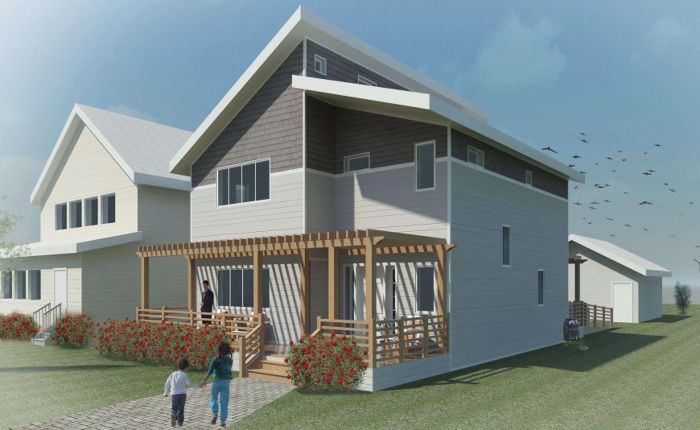
A team of students from the University of Minnesota came up with the winning entry in this year’s Race to Zero competition with a 2544-sq. ft., two-story house designed to be affordable as well as energy efficient.
The OptiMN Impact Home was designed specifically for infill lots in North Minneapolis and meets both the Department of Energy’s Zero Energy Ready Home criteria and a program established by the city of Minneapolis called Green Homes North. The project was a collaboration between the university and Urban Homeworks, a neighborhood development program in Minneapolis.
The aim of the competition, now in its second year, is to produce affordable, zero-energy homes that can be built by mainstream builders, according to DOE. It drew 33 teams from 27 different universities in Canada and the U.S., with winners announced last month at the National Renewable Energy Laboratory in Golden, CO.
DOE has posted a full list of entries and details about the houses they designed at its website.
Housing for a hard-hit part of town
The university team targeted a vacant lot in a section of North Minneapolis that was struck by tornados in 2011 and also affected by the foreclosure crisis a few years earlier, according to a fact sheet distributed by the team. There are many vacant lots in the area where Green Homes North plans to build 100 energy-efficient homes.
The house is designed for a 40-ft.-wide lot with its long axis facing south to make the most of solar gain. With most Minneapolis house lots running east-to-west, the team said, the design would be well suited to the area.
Among the features of the winning design are Energy Star appliances and windows, WaterSense low-flow plumbing fixtures, rainwater storage, LED lights, photovoltaic panels, low-VOC paints and finishes, and concrete made with fly-ash.
Total finished floor area is 1696 sq. ft. with another 848 sq. ft. in a lower level that also could be finished. The design includes three bedrooms and 1 1/2 bathrooms (plus another in the lower level).
Some of the details:
- Foundation: The slab and footings are insulated to R-10, foundation walls to R-15. Moisture control comes with capillary breaks, a waterproof membrane, perimeter drainage and a sealed sump basket.
- Exterior walls: The 2×4 stud walls are insulated with fiberglass batts, covered in Huber’s Zip sheathing, and insulated on the outside with 3 in. of extruded polystyrene insulation for a total R-value of R-32.
- Windows: Double-pane, low-e units with a U-value of 0.27 and a solar heat gain coefficient of 0.20.
- Roof: Vented, truss construction with a clerestory and insulated to R-53 with a combination of rigid polyisocyanurate and fiberglass batts.
- Mechanicals: For combined space and water heating, a Polaris condensing water heater, plus a SEER 14 inverter heat pump. Heating and cooling is fully ducted.
- Whole-house ventilation: Venmar energy-recovery ventilator.
- Photovoltaics: Twenty 410-watt panels for a total rated capacity of 8.2 kW, with an estimated annual output of 10,337 kWh of electricity. With PV, the house has a HERS score of 0.
Students estimated the house would cost $226,797 to build, well within reach for a family of four with a median income of about $64,000.
Fine Homebuilding Recommended Products
Fine Homebuilding receives a commission for items purchased through links on this site, including Amazon Associates and other affiliate advertising programs.

Reliable Crimp Connectors

8067 All-Weather Flashing Tape

Affordable IR Camera

A team from the University of Minnesota submitted this entry in the Race to Zero competition sponsored by the U.S. Department of Energy. The "OptiMN Impact Home" won top honors.



























View Comments
It's amazing to see even student jumping in to construct housing units that are an amazingly sustainable solution! We have hope for the future yet with the youth putting in their efforts to keep the Earth alive!